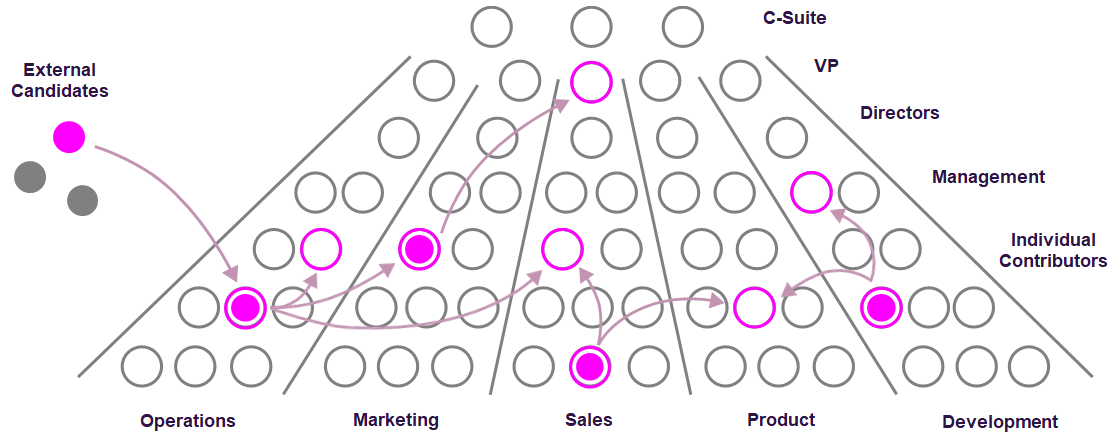Become an insider!
Get our latest payroll and small business articles sent straight to your inbox.
“Teamwork makes the dream work.” The first step to making the dream work is also having the right people on your team. The second is ensuring your team members are meeting their fullest potential.
Sounds simple — but sometimes things are easier said than done. We teamed up with Nora Jenkins Townson and Caitlin MacGregor, founders of Bright + Early and Plum, respectively, to bring our accounting and bookkeeping friends three big ideas to boost team-building.
1. Wagepoint and the Culture Call
Culture isn’t just about values. It’s about having a deliberate pact on how we all interact and behave with each other.
Shrad Rao, Wagepoint CEO
From the very beginning, Wagepoint CEO, Shrad made the conscious decision to build out a remote team — this is still a head-scratcher for most of his peers, but by establishing a strong culture, he was able to accomplish this with ease.
What is culture?
Culture is more than just values and ping pong tables — it is a collective entity, and the people you choose and culture you nurture are an integral part of this collective heartbeat.

Hiring and finding the right fit is so critical to culture. While candidates need to know how to do their job, their attitude is essential. Having a culture call is how you assess this.
The first step to finding the right fit — the table stakes.
The first call addresses the “what” of the role.
It’s more like a traditional interview where the hiring manager looks at whether the candidate understands the key requirements of the roles and, in turn, has the skills to do the job.
The final (and most important) step to finding the right fit — the culture call.
The final call addresses the “who” of the company and the “who” of the applicant.
The purpose is to see whether the candidate’s and Wagepoint’s heartbeats match. The way to achieve this is through an informal conversation. Shrad deliberately sets aside time to explain exactly who Wagepoint is as a collective entity — how we interact as a group, the types of people on the team, our values and what we stand for.
Fit is a conscious choice between both parties.
Greatness is not a function of circumstance. Greatness, it turns out, is largely a matter of conscious choice and discipline.
Jim Collins, Author, Good to Great
Fit is a two-way street — and the Culture Call helps both parties assess this.
“Since the other person is making a conscious to come into your company and participate with you, this is how you get a handshake from them to make sure they understand what it’s going to feel like when they come in.”
2. Bright + Early and feedback fundamentals
Feedback is a learned skill that requires time, practice and a dash of bravery. Learning to give, and just as importantly, to receive feedback is the number one hack to an aligned and psychologically safe workplace.
Five reasons why feedback is so valuable within teams.
Here are a few reasons why feedback is necessary, especially in a work setting:
- Lets you see how others perceive you. Even if you disagree with your teammate’s feedback, this is an opportunity for you to see how others have interpreted your actions or words.
- Helps avoid mistakes and miscommunications. Both of which tend to derail companies and ruin relationships. With drama out of the way, you can achieve great things!
- Prevents small things from becoming big things. In Nora’s words, “Being able to tell somebody they have a splinter before it turns into gangrene and their arm falls off.”
- Encourages growth and development. Depending on their client’s needs, Bright + Early may poll their teams to get a sense of what they need to grow. Nora has found that most employees ask for more structure, the chance to grow and develop as well as the guidance to do that. Feedback helps with charting the path to success.
- Forms stronger relationships and supports psychological safety. Psychological safety within a team setting means being able to show up as yourself, including the mistake-making human, without fear of punishment or humiliation. Having calm, honest and objective conversations aimed at helping the other person grow helps build bonds within teams.
How to receive feedback.
There is a saying that goes, “You cannot give what you do not have.” If you aren’t receptive to receiving feedback, others won’t be receptive to taking it from you. As a leader, you must demonstrate an openness to feedback to build psychological safety in the workplace.
Some ways to show that include:
- Being open about the times you were wrong. Showing your vulnerability side by openly admitting your mistakes helps build trust within the team. Own your slip up and let your team know what you’ve learned from it.
- Praising people who give others (including yourself) feedback. Not only should you give thanks to those who give feedback, but you should do it openly. This will build a culture where feedback is seen as a positive. Take it up a notch by actually acting on the feedback that you received and showing that you are making changes.
- Asking for feedback. Proactively request feedback, but be prepared to be met with reluctance as people may not feel comfortable giving it, especially to a leader. You can get around this by asking “go-to” questions.
- Using “go-to” questions. “Go-to” questions are pointed, but open-ended questions. For example, you can ask, “Do you have any ideas on how I can improve my organizational skills for the next project?” Again, giving feedback requires trust and psychological safety, which takes time to build. Don’t give up if your team members don’t give you feedback right away.
- Reflecting back. Show that you’re listening by repeating back the feedback and confirming what you’ve heard — this will help avoid miscommunication. “You might reflect back and say, ‘What I hear is that you felt like you weren’t heard when I said X’ and keep reflecting back by saying ‘Is that right?'”
- Holding your tongue, especially if you disagree. Many times, people will listen to respond, not understand. Feeling understood is a significant component of feedback. If you don’t agree with the feedback, don’t argue. Just absorb it. Make them feel heard and understood by reflecting back and take a day to think about it.
- Understanding that feedback is an opportunity for growth. Even if you disagree with the feedback, make it an opportunity to understand how the other person is perceiving you. “You might think, ‘Okay, I don’t agree with this, but why might I be perceived this way? What are some areas I can improve on?'” No matter if the feedback is positive or constructive, there’s always something to learn from it.
Whether you agree or not, receiving feedback is a gift.
— Nora Jenkins Townson, Bright + Early Founder and Principal
Do’s and don’ts of giving feedback.
There are right ways and wrong ways for giving feedback — here are some dos and don’ts:
- DON’T wait to deliver feedback. Feedback is a dish best served hot as it gives your teammate the chance to start improving right away.
- DON’T use the “sh*t sandwich.” This is when you slip in your feedback between two irrelevant compliments. For example, “Your hair looks great. Your presentation really sucked, but your shoes are amazing.” This doesn’t help your colleague, as they may miss the feedback altogether.
- DO practice. It isn’t easy to speak candidly about how your teammate can improve in a particular area, but practice makes perfect! Practice giving feedback to a person you trust, such as your partner or a trusted colleague.
- DO get training. Bright + Early offers bite-sized training sessions on feedback, which include multiple practice rounds to help their clients perfect their feedback communication skills.
Your brain will try to make a million excuses for you not to give feedback — ignore it. It is always the right choice. It’ll try and make excuses for you so be ready to circumvent your brain around this.
Nora Jenkins Townson, Bright + Early Founder and Principal
Three effective ways to deliver feedback.
There are many ways to deliver and frame your feedback. Nora recommends the following techniques:
1. Radical candor
Based on a book by Kim Scott called Radical Candor, this framework calls on two factors to consider as you provide feedback: how much you personally care about the other person and your willingness to challenge them.

- Ruinous empathy. A person will fall in this quadrant if they skip providing their colleague feedback altogether out of fear of hurting their feelings. This behaviour may be considerate, but it isn’t constructive.
- Manipulative insincerity. In this quadrant, the person just doesn’t care about their colleague and doesn’t want to put in the effort to help them grow. This is also unhelpful and will stunt growth.
- Obnoxious aggression. This treads toward animosity. These are the people who aren’t afraid to hurt the other person’s feelings with their feedback, which may even potentially come from a place of malice.
- Radical candor. This is the quadrant that you want to be in, as this is the best way to foster growth.
2. Situation, behaviour and impact (SBI)
SBI is helpful with framing feedback — this is a great starting place to avoid the “sh*t sandwich” as it focuses on facts and objectivity.
- Situation. Describe precisely where and when it happened.
- Behaviour. Objectively describe the behaviours or actions you observed — without judgment or assumptions.
- Impact. Use “I” statements to describe how the person’s action has affected you or others.
What SBI looks like:
Situation: As you know, we have a meeting every Monday at 10 AM. Behaviour: I noticed that you had arrived 15 minutes late for the last three meetings. Impact: I am worried that others may feel like you’re not respecting their time.
3. “I don’t, I do.”
Another way to frame your feedback is by using “I don’t, I do.” For example:
I don’t want you to feel like you have to rush to work, but I do need you to be on time to the things we commit to. How can we make this happen?
This lets the other person know that you understand their situation but still lets you be assertive.
Success in giving feedback — intention vs. impact.
Clarity gets measured at the listener’s ear, not at the speaker’s mouth.
Kim Scott, Author, Radical Candor
The impact of your feedback depends on the receiver. Even if you had good intentions for your delivery, if the feedback was given in a way that was not clear or received well by your colleague, then it was not successful.
3. Plum and promoting potential
When it comes to promotions, there’s more to consider outside of job history — including innate talents and the potential for burn out. Keeping these in mind will ensure that your team and business results are optimized.
Ditch the career ladder for the career lattice.
If you truly want the right people in the right seats at the right time, then you need to embrace a new career development model — the career lattice.

This entails breaking down the silos between departments and moving people to where they are going to thrive because you’re utilizing their innate transferable talents — “the things that make them thrive and the things that really energize them.”
When we can align what makes somebody exceptional with the behavioural needs of the role, that’s where we end up having a high-performing team.
Optimizing people for what drives them and promoting learning on the job allows for an agile organization.
Caitlin MacGregor, Plum CEO and Co-founder
Identifying your top talents — meet Laura, Underwriter-turned-Product-Manager.

Laura is a Product Manager and top performer at Plum. She began as an underwriter. Caitlin explained that, based on her skills and talents, she was able to move to Customer Success to eventually become “the best Product Manager we could hope for.”
On the surface level, there’s nothing to tell you that an underwriter would be a fantastic product manager — it ultimately comes down to the transferable talents.
Create your own Plum Profile and identify your top talents.
The value of understanding potential.
Here are a few reasons why you should embrace a full understanding of team potential:
- Optimizes teams by understanding what Drives and Drains each other. Recognizing your talents and what they entail lets you be explicit with your coworkers in your teams what drives you and what doesn’t.
- Balances polarizing perspectives. It’s not uncommon to have a common underlying trait within your team — as the saying goes, “Birds of a feather, flock together.” That said, once you understand these natural tendencies as a team, you can actively search for a solution to balance it out. In Caitlin’s case, everyone in her executive team was strong in “execution,” but they scored low in “teamwork” across the board. She hired a Director of People and Culture to balance out her team and own that piece of their culture.
- Builds empathy on teams, especially while working from home (WFH). Understanding that everyone brings different things to the table makes you more aware and empathetic about each person’s working styles.
Thank you, Nora and Caitlin, for joining us to talk about all things culture, employee management and human potential!
About our fellow presenters:
Bright + Early is a collective of modern HR experts on a mission to craft the world’s best workplaces. We partner with early- to mid-stage companies who need to scale fast but stay friendly.
Plum quantifies human potential by measuring talents, such as adaptability, innovation and communication — matching people with jobs where they thrive.
The advice we share on our blog is intended to be informational. It does not replace the expertise of accredited business professionals.













